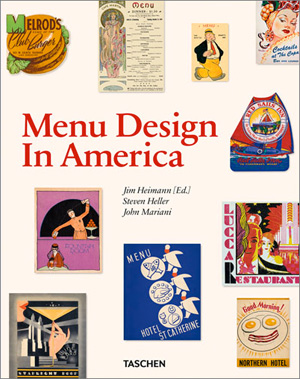 Millions of people all over the world will open a restaurant menu today. They will look at menus for the food and the price and make their selection, then the menu will lay on the table, ignored, an annoyance taking up elbow space.
Millions of people all over the world will open a restaurant menu today. They will look at menus for the food and the price and make their selection, then the menu will lay on the table, ignored, an annoyance taking up elbow space.
Not so for Jim Heinmann, whose new book Menu Design in America: 1850-1985 (Taschen) asks that you set aside the hunger pangs and examine the menu, admire its design. Heimann’s book made its appearance at one of the best-catered signings in recent history. Delicacies and drinks provided by Taschen’s Beverly Hills store’s glamorous neighbors: Mr. Chow, Spago, The Cheese Story Beverly Hills, Vosges Haut Chocolate, The Spare Room and Remy U.S.A.
The dress code was country club casual. I was struck by a number of women with seventy-year old hands and faces as smooth as river stones in pretty summer dresses, light layers of lavender and other gentle shades of purple daringly accented with a coral pink or chartreuse accessory. Their hair was sparse with age but coiffed into cotton candy halos. It was all very Palm Beach or Palm Springs on Easter Sunday, or Beverly Hills before black became de rigueur. None of them smoked, not upstairs at the open-air bar or out on the clean, expansive sidewalk, but their hushed, hoarse voices betrayed a secret habit, some sweet vice recently abandoned.
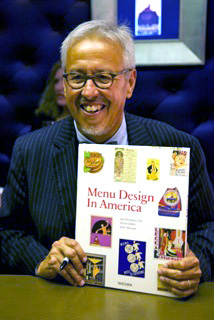 |
| Photo Credit: Dalmiro Quiroga |
Mr. Wolfgang Puck turned up to make sure everything was up to snuff. As he made his way to the back of the long, narrow room, we rubbed bellies. Our eyes met and I felt I had to say something so I shouted in his ear, “Wolfgang, I’m so glad you’re here.”
Why did I feel the need to say that, sounding like it was my party, like Vanessa Redgrave as Mrs. Dalloway greeting the Prime Minister or an old lover. I guess I truly was glad to see him. I do admire Mr. Puck, I am in awe of his enduring success.
According to Business Week, “about one in four restaurants close within their first year of business. Over three years, that number rises to three in five.” In spite of the odds, for many, restaurants are dreams come true.
This dream was recently dramatized in the popular HBO miniseries, Mildred Pierce. Here is Mildred’s moment, when after laboring as a waitress, she decides to change her life.
Wally: What's all this?
Mildred: I’m going to open a restaurant.
Wally: You are?
Mildred: And you're going to help me.
Wally: I am? I mean, am I?
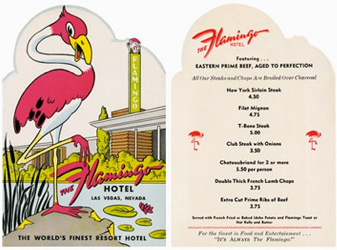 Mildred Pierce dreams of rising above her pink-collar life and believes that a successful restaurant will initiate that climb.
Mildred Pierce dreams of rising above her pink-collar life and believes that a successful restaurant will initiate that climb.
For restaurant owners of her era, and the menus they created the initial fun can’t be denied: finding the dream location, the dream décor, and creating the dream menu - not just the dishes to be served but the design of the menu, then considered “the handshake of the proprietor.” Yes, there was a time, before blank was considered classy, when the illustration on the cover of a menu told customers what the place promised.
A flying fish.
A leaning tower.
A pagoda.
It was an almost subliminal message but one that captured Jim Heimann’s attention thirty years ago. His collection, picked up piecemeal at swap meets and flea markets is now 5,000 strong (only 800 of which are featured in his book).
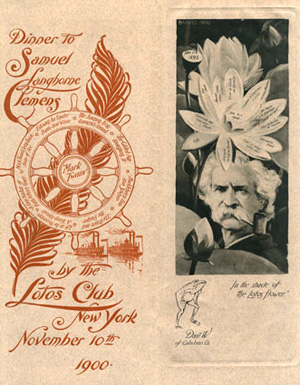 My personal favorite dates back to November 10th, 1900. It is the menu from a dinner at the Lotus Club in New York in honor of Mark Twain The cover of the menu features a photographic rendering of Mr. Twain, very serious face, something out of Mt. Rushmore – with a lotus blossom (unintentionally?) growing out of his head.
My personal favorite dates back to November 10th, 1900. It is the menu from a dinner at the Lotus Club in New York in honor of Mark Twain The cover of the menu features a photographic rendering of Mr. Twain, very serious face, something out of Mt. Rushmore – with a lotus blossom (unintentionally?) growing out of his head.
I talked to Jim Heimann about his passion for the past and wondered if it had crossed over to obsession, and if it was an obsession worth having. Heimann can best be described as a natty fellow, trim, affable, and given to wearing bowties. His work keeps him rummaging in the past, but he clearly lives in the present, if not the future.
“Was there a tah dah moment when you suddenly looked at a menu in a different way?” I asked him.
“It was not like being struck by lightning,” he said with a chuckle. “More like there was a menu here and there that I admired and I casually took it home. They started to add up.”
“Did you think, way back then, that it would end up becoming a book?”
He did. “Somewhere in the back of my mind I thought it might be of interest as a collection. I knew they would tell a story.”
Jim is friendly, a fast talker and an even fast thinker and one topic leads to another. Questioned on some current favorites, without a moment’s hesitation he cited Musso and Frank’s Grill.
“They haven’t changed their menu in sixty years. And Tom Bergin’s Tavern is bringing back its 1949 logo on their revamped menu.
What are his biggest disappointments? “Truman Capote’s Black and White Ball did not have a menu. And the Academy Awards banquets’ menus were surprisingly lackluster.”
“How do you feel about the current trend of restaurants using blackboards to post their menu?” I asked.
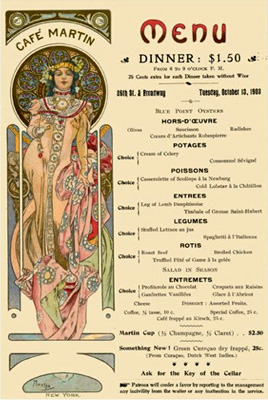 “That’s a throwback to the original menus,” he said. “That’s the way it was done up to the 1900s when printing became accessible. I don’t begrudge them, each restaurant represents itself in its own way.
“That’s a throwback to the original menus,” he said. “That’s the way it was done up to the 1900s when printing became accessible. I don’t begrudge them, each restaurant represents itself in its own way.
What interested me were the ones who printed them and used graphic illustrations. I saw its value in the way American culture has evolved, from when only the wealthy could eat at restaurants to the proliferation of family restaurants and diners, where the not-so-elite meet to eat.”
Now that his menus compose a book, does he have a new passion? “Matchbook covers, greeting cards, cookbook covers, cruise lines, they all tell a story about America’s buying habits and cultural changes. But all that ephemera has been done. The menus were great, but I do have something new planned.”
I waited for him to keep this information a secret, but he revealed it with his next breath.
“Automobile brochures. I have one that dates back to 1902. They also tell a story about the evolution of the American middle class.”
“A vanishing breed,” I sigh.
“Ephemera,” he sighs back, using a word I suspect is a favorite of his.
Eduardo Santiago is the author of the award-winning novel, Tomorrow They Will Kiss.

